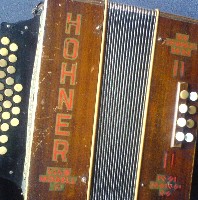Melodeon
The Melodeon, as defined by folk music performers in England, is one of the major instruments in the English folk tradition.
Despite the use of the name 'melodeon' to describe a range of instruments, (See Wikipedia entry), English folk musicians understand the instrument to be a button accordion with the following features:
- one, two, two and a half or three rows of buttons on the melody side
- between two and eight buttons on the bass side
- bisonoric in nature - ie. a different note for each button depending on the bellows being compressed or expanded (popularly referred to as a Push/Pull instrument).
The buttons are not in a chromatic format but in a major scale format. The C major scale is played as C,D,E,F,G,A,B,C (where as the C chromatic scale is C,Csharp,D,Dsharp,E,E sharp etc).
For the latter years of the 20th century, the most popular melodeon was the Poker Work instrument manufactured by Hohner of Trossingen in Baden-Wuerttemberg. There were several other models manufactured by Hohner including the Erica , the Double Ray and the Club. There were also many Hohner One-Row melodeons in use.
In more recent years, players have favoured melodeons from other makers including Salterelle, Castagnari, Scarlatti, other European makers and also melodeons sourced in Louisiana where the instrument is integral to Cajun Music.
